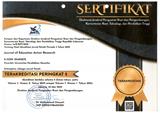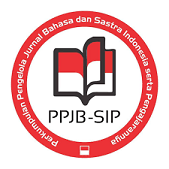PENGGUNAAN GAMBAR BERSERI UNTUK MENINGKATKAN KEMAMPUAN MENULIS TEKS PROSEDUR KOMPLEKS PADA SISWA KELAS X AKUNTANSI A SMK NEGERI 1 SINGARAJA
DOI:
https://doi.org/10.23887/jjpbs.v3i1.6257Abstrak
Penelitian tindakan kelas (PTK) ini bertujuan (1) mendeskripsikan proses pembelajaran menulis teks prosedur kompleks dengan menggunakan gambar berseri pada siswa kelas X Akuntansi A SMK Negeri 1 Singaraja, (2) mendeskripsikan peningkatan kemampuan menulis teks prosedur kompleks dengan menggunakan gambar berseri pada siswa kelas X Akuntansi A SMK Negeri 1 Singaraja, dan (3) mendeskripsikan pandangan siswa kelas X Akuntansi A SMK Negeri 1 Singaraja terhadap pembelajaran menulis teks prosedur kompleks dengan menggunakan gambar berseri. Subjek penelitian ini adalah siswa kelas X Akuntansi A SMK Negeri 1 Singaraja. Metode pengumpulan data yang digunakan yaitu, metode observasi, penugasan, dan bercerita. Data dianalisis dengan menggunakan teknik deskriptif kuantitatif dan kualitatif. Hasil penelitian ini adalah (1) proses pembelajaran berjalan dengan baik dan siswa aktif dalam melaksanakan kegiatan pembelajaran, (2) tercapainya ketuntasan hasil belajar menulis teks prosedur kompleks siswa, yakni pada siklus I memperoleh skor rata-rata 74,9, sedangkan pada siklus II nilai rata-rata siswa menjadi 80,42, dan (3) siswa sangat senang terhadap penggunaan gambar berseri dalam pembelajaran menulis teks prosedur kompleks. Berdasarkan hasil penelitian ini, peneliti lain disarankan untuk menerapkan penggunaan gambar berseri pada materi bahasa indonesia yang lain, seperti menulis teks prosedur kompleks.Kata Kunci : gambar berseri, kemampuan menulis, teks prosedur kompleks
This Classroom Action Research has purpose (1) to describe the process of writing complex procedure text learning using of chapter picture for increasing the abillity of writing complex procedure text to the X grade Accountant A students in SMK Negeri 1 Singaraja, (2) to describe the increasing of writing complex procedure text to the X grade Accountant A students in SMK Negeri 1 Singaraja, and (3) to describe the students view of X grade Accountant A students in SMK Negeri 1 Singaraja toward writing complex procedure text learning using chapter picture. The subject of this research is X grade Accountant A students in SMK Negeri 1 Singaraja. The methods in collecting the data are using, observation, assignment, and stary telling. The data was analysed using descriptive cuantitative and cualitative methods. The result of this research are (1) the learning process run well and the students were active in doing the learning process, (2) the achieving of the learning result in writing students complex procedure, that is in siclus I got the avarage score 74,9, while in siclus 2 the students avarage score become 80,42, and (3) the students were very happy of using the chapter picture in writing complex procedure learning. Based on the result of this research, this research is recomended to apply the using of chapter picture in other Indonesian language material, like writing complax procedure text.
keyword : chapter picture, abillity of writing, complex procedure text.
Diterbitkan
2015-11-06
Terbitan
Bagian
Articles
Lisensi
Authors who publish with the Jurnal Pendidikan Bahasa dan Sastra Indonesia Undiksha agree to the following terms:- Authors retain copyright and grant the journal the right of first publication with the work simultaneously licensed under a Creative Commons Attribution License (CC BY-SA 4.0) that allows others to share the work with an acknowledgment of the work's authorship and initial publication in this journal
- Authors are able to enter into separate, additional contractual arrangements for the non-exclusive distribution of the journal's published version of the work (e.g., post it to an institutional repository or publish it in a book), with an acknowledgment of its initial publication in this journal.
- Authors are permitted and encouraged to post their work online (e.g., in institutional repositories or on their website) prior to and during the submission process, as it can lead to productive exchanges, as well as earlier and greater citation of published work. (See The Effect of Open Access)







